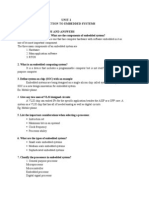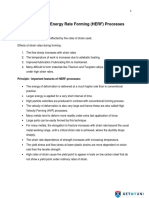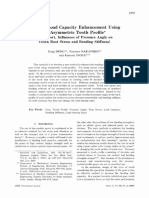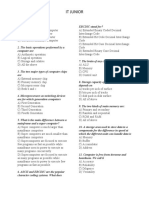100%(1)100% found this document useful (1 vote)
110 viewsUnit I Overview & Instructions: Cs6303-Computer Architecture
Unit I Overview & Instructions: Cs6303-Computer Architecture
Uploaded by
tamizhanps1) The document discusses key concepts in computer architecture including components of a computer system, technologies for building processors and memory, and hierarchical layers of hardware and software.
2) It describes different types of computer applications like personal computers, servers, supercomputers, and embedded computers.
3) Eight great ideas in computer architecture are outlined, focusing on techniques like pipelining, parallelism, and memory hierarchies to improve performance.
Copyright:
© All Rights Reserved
Available Formats
Download as DOC, PDF, TXT or read online from Scribd
Unit I Overview & Instructions: Cs6303-Computer Architecture
Unit I Overview & Instructions: Cs6303-Computer Architecture
Uploaded by
tamizhanps100%(1)100% found this document useful (1 vote)
110 views16 pages1) The document discusses key concepts in computer architecture including components of a computer system, technologies for building processors and memory, and hierarchical layers of hardware and software.
2) It describes different types of computer applications like personal computers, servers, supercomputers, and embedded computers.
3) Eight great ideas in computer architecture are outlined, focusing on techniques like pipelining, parallelism, and memory hierarchies to improve performance.
Original Description:
computer architecture
Original Title
ca_notes1
Copyright
© © All Rights Reserved
Available Formats
DOC, PDF, TXT or read online from Scribd
Share this document
Did you find this document useful?
Is this content inappropriate?
1) The document discusses key concepts in computer architecture including components of a computer system, technologies for building processors and memory, and hierarchical layers of hardware and software.
2) It describes different types of computer applications like personal computers, servers, supercomputers, and embedded computers.
3) Eight great ideas in computer architecture are outlined, focusing on techniques like pipelining, parallelism, and memory hierarchies to improve performance.
Copyright:
© All Rights Reserved
Available Formats
Download as DOC, PDF, TXT or read online from Scribd
Download as doc, pdf, or txt
100%(1)100% found this document useful (1 vote)
110 views16 pagesUnit I Overview & Instructions: Cs6303-Computer Architecture
Unit I Overview & Instructions: Cs6303-Computer Architecture
Uploaded by
tamizhanps1) The document discusses key concepts in computer architecture including components of a computer system, technologies for building processors and memory, and hierarchical layers of hardware and software.
2) It describes different types of computer applications like personal computers, servers, supercomputers, and embedded computers.
3) Eight great ideas in computer architecture are outlined, focusing on techniques like pipelining, parallelism, and memory hierarchies to improve performance.
Copyright:
© All Rights Reserved
Available Formats
Download as DOC, PDF, TXT or read online from Scribd
Download as doc, pdf, or txt
You are on page 1of 16
CS6303-COMPUTER ARCHITECTURE
UNIT I OVERVIEW & INSTRUCTIONS
Eight ideas Components of a computer system Technology Performance Power wall
Uniprocessors to multiprocessors; Instructions operations and operands representing
instructions Logical operations control operations Addressing and addressing modes.
Machine Structures
Casses !" C!#$utin% A$$icati!ns an& Their Characteristics
Pers!na c!#$uters 'PCs(
Personal computers emphasie deli!ery of good performance to single users at low cost and
usually e"ecute third#party soft ware. A computer designed for use $y an indi!idual% usually
incorporating a graphics display% a &ey$oard% and a mouse.
Ser)ers
A computer used for running larger programs for multiple users% oft en simultaneously% and
typically accessed only !ia a networ&. Ser)ers are the modern form of what were once much
larger computers% and are sually accessed only !ia a networ&. 'er!ers are oriented to carrying
large wor&loads% which may consist of either single comple" applications(usually a scientifi c
or engineering application(or handling any small )o$s% such as would occur in $uilding a large
we$ ser!er.
Th ese low#end ser!ers are typically used for fi le storage% small $usiness applications% or simple
we$ ser!ing. At the other e"treme are su$erc!#$uters% which at the present consist of tens of
thousands of processors and many tera*+tes of memory% and cost tens to hundreds of millions
of dollars.
A$$icati!ns !" Su$erc!#$uters,
high#end scientifi c and engineering calculations% such as weather forecasting% oil e"ploration%
protein structure determination% and other large#scale pro$lems.
E#*e&&e& c!#$uters
A computer inside another de!ice used for running one predetermined application or collection
of soft ware.
*************###################################################**************
EI-HT -REAT I.EAS IN COMPUTER ARCHITECTURE
/0 .esi%n "!r M!!re1s 2a3
The numbers of transistors incorporated in a chip will approximately double every 24
months
M!!re1s a3 resute& "r!# a /465 $re&icti!n !" such %r!3th in IC ca$acit+ #a&e *+
-!r&!n M!!re6 c!-"!un&er !" Inte0
70 Use A*stracti!ns t! Si#$i"+ .esi%n
A ma)or producti!ity techni+ue for hardware and software is to use a$stractions to represent the
design at different le!els of representation% lower#le!el details are hidden to offer a simpler
model at higher e!els.
30 Ma8e the c!##!n case "ast
,a&ing the common case fast will tend to enhance performance $etter than optimiing the rare
case. Ironically% the common case is often simpler than the rare case and hence is often easier to
enhance.
90 Per"!r#ance )ia Paraeis#
Computer architects ha!e offered designs that get more performance $y performing operations in
parallel.
Parallel -e+uests Assigned to computer e.g. search ./arcia0
Parallel Threads Assigned to core e.g. loo&up% ads
Parallel Instructions 1 2 instruction 3 one time e.g. 4 pipelined instructions
Parallel 5ata 1 2 data item 3 one time e.g. add of 6 pairs of words
50 Per"!r#ance )ia Pi$einin%
Pipelining is an implementation techni+ue where multiple instructions are o!erlapped in
e"ecution. The computer pipeline is di!ided in stages. Each stage completes a part of an
instruction in parallel. The stages are connected one to the ne"t to form a pipe # instructions enter
at one end% progress through the stages% and e"it at the other end.
60 Per"!r#ance )ia Pre&icti!n
In some cases it can $e faster on a!erage to guess and start wor&ing rather than wait until you
&now for sure% assuming that the mechanism to reco!er from a misprediction is not too e"pensi!e
and your prediction is relati!ely accurate.
:0 Hierarch+ !" #e#!ries
Programmers want memory to $e fast% large% and cheap% as memory speed often shapes
performance% capacity limits the sie of pro$lems that can $e sol!ed% and the cost of memory
today is often the ma)ority of computer cost. Architects ha!e found that they can address these
conflicting demands with a hierarchy of memories% with the fastest% smallest% and most e"pensi!e
memory per $it at the top of the hierarchy and the slowest% largest% and cheapest per $it at the
$ottom. Caches gi!e the programmer the illusion that main memory is nearly as fast as the top of
the hierarchy and nearly as $ig and cheap as the $ottom of the hierarchy. A layered triangle icon
is used to represent the memory hierarchy. The shape indicates speed% cost% and sie7 the closer to
the top% the faster and more e"pensi!e per $it the memory; the wider the $ase of the layer% the
$igger the memory.
;0 .e$en&a*iit+ )ia Re&un&anc+
Computers not only need to $e fast; they need to $e dependa$le. 'ince any physical
de!ice can fail% we ma&e systems dependa$le $y including redundant components that
can ta&e o!er when a failure occurs and to help detect failures.
8 ################################################################# "
C!#$!nents !" a c!#$uter s+ste#
The underlying hardware in any computer performs the same $asic functions7 inputting
data% outputting data% processing data% and storing data.
In$ut &e)ice
A mechanism through which the computer is fed information% such as a &ey$oard.
Out$ut &e)ice
A mechanism that con!eys the result of a computation to a user% such as a display% or to another
computer.
'CPU( Also called processor. The acti!e part of the computer% which contains the datapath and
control and which adds num$ers% tests num$ers% signals I9: de!ices to acti!ate% and so on.
.ata$ath
The component of the processor that performs arithmetic operations
C!ntr!, The component of the processor that commands the datapath% memory% and I9:
de!ices according to the instructions of the program.
Me#!r+
Th e storage area in which programs are &ept when they are running and that contains the data
needed $y the running programs.
Th e #e#!r+ is where the programs are &ept when they are running; it also contains the data
needed $y the running programs. Th e memory is $uilt from 5-A, chips. DRAM stands for
&+na#ic ran&!# access #e#!r+. ,ultiple 5-A,s are used together to contain the
instructions and data of a program. In contrast to se+uential access memories% such as magnetic
tapes% the RAM portion of the term 5-A, means that memory accesses ta&e $asically the same
amount of time no matter what portion of the memory is read.
.+na#ic ran&!# access #e#!r+ '.RAM(
,emory $uilt as an integrated circuit; it pro!ides random access to any location. Access times
are 4; nanoseconds and cost per giga$yte in <;2< was =4 to =2;.
""#####################################################################################################""
Hierarchica a+ers !" har&3are an& s!"t3are
>igure shows that the layers of software are organied primarily in a hierarchical fashion% with
applications $eing the outermost ring and a !ariety of systems software sitting $etween the
hardware and applications software.
System Software7 'oftware that pro!ides ser!ices that are commonly useful% including operating
systems% compilers% loaders% and assem$lers.
There are many types of systems software% $ut two types of systems software are central to e!ery
computer system software today7 an operating system and a compiler.
An :perating system interfaces $etween a user?s program and the hardware and pro!ides a
!ariety of ser!ices and super!isory functions. Among the most important functions are7
@andling $asic input and output operations
Allocating storage and memory
Pro!iding for protected sharing of the computer among multiple applications using it
simultaneously.
E"amples of operating systems in use today are Linu"% i:'% and Aindows
Compiler: A program that translates high#le!el language statements into assem$ly language
statements.
Instruction7 A command that computer hardware understand and o$eys.
Assembler: A program that translates a sym$olic !ersion of instructions into the $inary !ersion
Assembly an!ua!e7 A sym$olic representation of machine instructions.
"achine an!ua!e7 A $inary representation of machine instructions.
*******************##############################******************
Techn!!%ies "!r <ui&in% Pr!cess!rs an& Me#!r+
Processors and memory ha!e impro!ed at an incredi$le rate% $ecause computer designers ha!e
long em$raced the latest in electronic technology to try to win the race to design a $etter
computer.
A transistor is simply an on9off switch controlled $y electricity. The integrated circuitBICC
com$ined doens to hundreds of transistors into a single chip. To descri$e the tremendous
increase in the num$er of transistors from hundreds to million% the ad)ecti!e !ery large scale is
added to the term% creating the a$$re!iation DL'I% for !ery large scale integrated circuit.
The process starts with a silicon crystal ingot which loo&s li&e a giant sausage. An ingot is finely
sliced into wafers no more than ;.2 inches thic&. These wafers then go through a series of
processing steps% during which patterns of chemicals are placed on each wafer% creating the
transistors% conductors and insulators.
"anufacturin! #rocess of $nte!rated Circuits
The patterned wafer is then chopped up% or diced% into these components called dies and more
informally &nown as chi$s.
5icing ena$les you to discard only those dies that were unluc&y enough to contain the fl aws%
rather than the whole wafer. This concept is +uantified $y the +ie& of a process% which is defined
as the percentage of good dies from the total num$er of dies on the wafer.
The cost of an integrated circuit rises +uic&ly as the die sie increases% due $oth to the lower
yield and the smaller num$er of dies that fit on a wafer. To reduce the cost% using the ne"t
generation process shrin&s a large die as it uses smaller sies for $oth transistors and wires. This
impro!es the yield and the die count per wafer.
The cost of an IC can $e e"pressed in three simple e+uations7
**************#####################*****************
Per"!r#ance
Accurately measuring and comparing different computers is critical. Performance can $e
determined $y different ways.
Res$!nse ti#e Also called e=ecuti!n ti#e. Th e total time re+uired for the computer to
complete a tas&% including dis& accesses% memory accesses% I9: acti!ities% operating system
o!erhead% CPU e"ecution time% and so on.
5atacenter managers are oft en interested in increasing thr!u%h$ut or *an&3i&th(the total
amount of wor& done in a gi!en time.
Thr!u%h$ut an& Res$!nse Ti#e
5o the following changes to a computer system increase throughput% decrease response time% or
$othE
2. -eplacing the processor in a computer with a faster !ersion
<. Adding additional processors to a system that uses multiple processors
for separate tas&s(for e"ample% searching the we$
5ecreasing response time almost always impro!es throughput. @ence% in case 2% $oth response
time and throughput are impro!ed. In case <% no one tas& gets wor& done faster% so only
throughput increases.
Performance of computers primarily concerned with response time. To ma"imie performance%
minimie the response time of e"ecution time for some tas&. Thus% performance and e"ecution
time can $e related for a computer 8 as%
Performance of two different computers can $e related +uantitati!ely li&e .8 is n times faster
than F0 or e+ui!alently .8 is n times as fast as F0 to mean
Measurin% Per"!r#ance
Time is the measure of computer performance7 the computer that performs the same
amount of wor& in the least time is the fastest. Program execution time is measured in seconds
per program.
Th e most straightforward defi nition of time is called wall clock time% response time% or elapsed
time. Th ese terms mean the total time to complete a tas&% including dis& accesses% memory
accesses% input/output BI9:C acti!ities% operating system o!erhead(e!erything.
CPU e=ecuti!n ti#e Also called CPU ti#e. Th e actual time the CPU spends computing
for a specific tas&.
User CPU ti#e , The CPU time spent in a program itself.
S+ste# CPU ti#e The CPU time spent in the operating system performing tas&s on $ehalf of the
program.
Almost all computers are constructed using a cloc& that determines when e!ents ta&e place in the
hardware. Th ese discrete time inter!als are called c!c8 c+ces Bor tic8s% c!c8 tic8s% c!c8
$eri!&s% c!c8s% c+cesC. 5esigners refer to the length of a c!c8 $eri!& $oth as the time for a
complete clock cycle Be.g.% <4; picoseconds% or <4; psC and as the clock rate Be.g.% 6 gigahert% or
6 /@C% which is the in!erse of the cloc& period.
CPU Per"!r#ance an& Its >act!rs
Users and designers oft en e"amine performance using different metrics. A simple formula
relates the most $asic metrics Bcloc& cycles and cloc& cycle timeC to CPU time7
This formula ma&es it clear that the hardware designer can impro!e performance $y reducing the
num$er of cloc& cycles re+uired for a program or the length of the cloc& cycle.
Instructi!n Per"!r#ance
The num$er of cloc& cycles re+uired for a program
The term c!c8 c+ces $er instructi!n% which is the a!erage num$er of cloc& cycles each
instruction ta&es to e"ecute% is oft en a$$re!iated as CPI. 'ince different instructions may ta&e
diff erent amounts of time depending on what they do% CPI is an a!erage of all the instructions
e"ecuted in the program. CPI pro!ides one way of comparing two diff erent implementations of
the same instruction set architecture% since the num$er of instructions e"ecuted for a program
will% of course% $e the same.
The performance of a program depends on the algorithm% the language% the compiler% the
architecture and the actual hardware. The following ta$le summaries how these components
affect the factors in the CPU performance e+uation.
A#&ah1s 2a3
Amdahl?s Law states that the performance impro!ement to $e gained from using some faster
mode of e"ecution is limited $y the fraction of the time the faster mode can $e used.
The P!3er 3a
Goth cloc& rate and power increased rapidly and grew together since they are correlated. Gattery
life can trump performance in the personal mo$ile de!ice% and the architects of warehouse scale
computers try to reduce the costs of powering and cooling 2;;%;;; ser!ers as the costs are high
at this scale. Hust as measuring time in seconds is a safer measure of program performance than a
rate li&e ,IP'% the energy metric )oules is a $etter measure than a power rate li&e watts% which is
)ust )oules9second.
The dominant technology for integrated circuits is called C,:' Bcomplementary metal o"ide
semiconductorC. >or C,:'% the primary source of energy consumption is so#called dynamic
energy(that is% energy that is consumed when transistors switch states from ; to 2 and !ice
!ersa. The dynamic energy depends on the capaciti!e loading of each transistor and the !oltage
applied7
>re+uency switched is a function of the cloc& rate. Th e capaciti!e load per transistor is a
function of $oth the num$er of transistors connected to an output Bcalled the fanoutC and the
technology% which determines the capacitance of $oth wires and transistors.
**********************#############################************************
The switch from Uni$r!cess!rs t! Muti$r!cess!rs
-easons for switching from unicore processors to ,ulticore processors7
5ifficult to ma&e single#core cloc& fre+uencies e!en higher
5eeply pipelined circuits7
heat pro$lems
speed of light pro$lems
difficult design and !erification
large design teams necessary
ser!er farms need e"pensi!e air#conditioning
,any new applications are multithreaded
/eneral trend in computer architecture Bshift towards more parallelismC
You might also like
- E-Ball TechnologyDocument36 pagesE-Ball Technologypreethamhc75% (4)
- Computer Science and Engineering (Course 6-3) MITDocument4 pagesComputer Science and Engineering (Course 6-3) MITwhNo ratings yet
- UNIT-1 Introduction To Embedded Systems Two Mark Questions and AnswersDocument30 pagesUNIT-1 Introduction To Embedded Systems Two Mark Questions and AnswersBharath RamanNo ratings yet
- With A Neat Schematic Block Diagram of A Digital Computer Describe Its Functional Units. Central Processing UnitDocument10 pagesWith A Neat Schematic Block Diagram of A Digital Computer Describe Its Functional Units. Central Processing UnitSrinivasan SriniNo ratings yet
- System Unit & Input/ Output Devices & Secondary StorageDocument20 pagesSystem Unit & Input/ Output Devices & Secondary StorageSaya Munir100% (1)
- Purpose and Function of The CPUDocument16 pagesPurpose and Function of The CPUsophiegcseNo ratings yet
- Chapter 4 The Components of The System UnitDocument8 pagesChapter 4 The Components of The System Unitpiash246No ratings yet
- Unit - 1 (Problem Solving and Program Desing in C UNIT - 1Document27 pagesUnit - 1 (Problem Solving and Program Desing in C UNIT - 1syam_5491983No ratings yet
- A Brief History of Computers and NetworksDocument4 pagesA Brief History of Computers and Networksmiryan712No ratings yet
- PCS Algebra I Quiz 4 Chapter Review KEYDocument1 pagePCS Algebra I Quiz 4 Chapter Review KEYTim Ricchuiti100% (1)
- Gear Motors: Achieving The Perfect Motor & Gearbox MatchDocument16 pagesGear Motors: Achieving The Perfect Motor & Gearbox MatchJohn LeeNo ratings yet
- Quadratic: GraphDocument35 pagesQuadratic: GraphHiếu Phong ĐỗNo ratings yet
- High Performance: Vertical Machining CentersDocument6 pagesHigh Performance: Vertical Machining CentersSandeep SNo ratings yet
- TER201 Lecture 6Document66 pagesTER201 Lecture 6lnxxNo ratings yet
- Analysis of Stress and Deflection of Spur Gear by Using New Analytical Method Based On Taguchi Method and Finite Element AnalysisDocument7 pagesAnalysis of Stress and Deflection of Spur Gear by Using New Analytical Method Based On Taguchi Method and Finite Element AnalysisEditor IJTSRDNo ratings yet
- Small Servo Drive System Gen2 enDocument53 pagesSmall Servo Drive System Gen2 enLABMTQNo ratings yet
- Ecuaciones en DiferenciaDocument57 pagesEcuaciones en DiferenciaJuan PabloNo ratings yet
- Catalogue V20 PDFDocument404 pagesCatalogue V20 PDFUstad Remy0% (1)
- Design and Analysis of Fixed-Segment Carrier at Carbon Thrust BearingDocument10 pagesDesign and Analysis of Fixed-Segment Carrier at Carbon Thrust BearingIJRASETPublicationsNo ratings yet
- UNIT 8: High Energy Rate Forming (HERF) ProcessesDocument9 pagesUNIT 8: High Energy Rate Forming (HERF) ProcessesLeo Dev WinsNo ratings yet
- FMC Technologies E-Brochure 2010Document8 pagesFMC Technologies E-Brochure 2010MarkNo ratings yet
- Collar Muffler MountDocument1 pageCollar Muffler MountPreetam KumarNo ratings yet
- Captura de Pantalla 2023-05-21 A La(s) 11.52.41 P.M.Document4 pagesCaptura de Pantalla 2023-05-21 A La(s) 11.52.41 P.M.abiNo ratings yet
- Techniques of Demand ForecastingDocument19 pagesTechniques of Demand ForecastingBhanuprasad sridharaNo ratings yet
- Power Skiving PDFDocument11 pagesPower Skiving PDFmadhavikNo ratings yet
- Designing and Building Gearboxes - 12 StepsDocument4 pagesDesigning and Building Gearboxes - 12 Stepsarda akkayaNo ratings yet
- Spur Gear Tooth Stress Analysis and Stress Reduction: V.Rajaprabakaran Mr.R.AshokrajDocument11 pagesSpur Gear Tooth Stress Analysis and Stress Reduction: V.Rajaprabakaran Mr.R.AshokrajJojee MarieNo ratings yet
- SW FEA Tutorial ShaftDocument10 pagesSW FEA Tutorial ShaftJoséMiguelSánchezGNo ratings yet
- Axial Transport and Residence Time of MSW in Rotary KilnsDocument11 pagesAxial Transport and Residence Time of MSW in Rotary Kilnsjimmy_burgos_11No ratings yet
- Chain ConveyorsDocument4 pagesChain ConveyorsrakicNo ratings yet
- Optimization of Cold Rolling Mill ParameDocument6 pagesOptimization of Cold Rolling Mill Paramevo thanh lam100% (1)
- Line Reactors Can Protect Motors and Reduce Power Line Distortion From VfdsDocument2 pagesLine Reactors Can Protect Motors and Reduce Power Line Distortion From VfdspanchalabNo ratings yet
- japonesesCR PDFDocument7 pagesjaponesesCR PDFJavier Antonio Cardenas OliverosNo ratings yet
- Hardware and SoftwareDocument13 pagesHardware and SoftwareMaajith MarzookNo ratings yet
- Plate FeederDocument4 pagesPlate FeederAnonymous 8t0V9SNo ratings yet
- Workshop 17 Import Iges File and Auto-Tet Mesh The GeometryDocument20 pagesWorkshop 17 Import Iges File and Auto-Tet Mesh The Geometryaiyubi2No ratings yet
- Mercer Valve 9100 Relief Valve Flanged AEDocument16 pagesMercer Valve 9100 Relief Valve Flanged AEChristopher Kenneth ChoaNo ratings yet
- Interchangeability List For Glandless Pumps 2014: Reference No.: 1110.9-12Document76 pagesInterchangeability List For Glandless Pumps 2014: Reference No.: 1110.9-12Jorge VillalobosNo ratings yet
- Tolerance Class Designation (Description)Document2 pagesTolerance Class Designation (Description)Cristian PopescuNo ratings yet
- U 4 Surface Finishing Process PDFDocument37 pagesU 4 Surface Finishing Process PDFSubhadip MaliNo ratings yet
- Shimpo Circulute 3000 CatalogDocument36 pagesShimpo Circulute 3000 CatalogElectromateNo ratings yet
- Samyang Gear ReducerDocument6 pagesSamyang Gear Reducerjuliyanto88No ratings yet
- Cme 380 Automobile EngineeringDocument134 pagesCme 380 Automobile EngineeringJayasudhanNo ratings yet
- Adams Machinery Gear Advanced 3D ContactDocument2 pagesAdams Machinery Gear Advanced 3D ContactcoroNo ratings yet
- Sample 3D Projects - TMA SolutionsDocument15 pagesSample 3D Projects - TMA SolutionsTMA SolutionsNo ratings yet
- H-E Parts Allgo OverviewDocument8 pagesH-E Parts Allgo OverviewJorge VillalobosNo ratings yet
- Minerals Processing EngineeringDocument15 pagesMinerals Processing EngineeringMohammad NuruzzamanNo ratings yet
- Unit Operations - George Granger Brown ... (Et Al.) - PDFDocument8 pagesUnit Operations - George Granger Brown ... (Et Al.) - PDFMegatantri Sekar HapsariNo ratings yet
- Application of Chain Drive and Its Selection Method in AutomobileDocument18 pagesApplication of Chain Drive and Its Selection Method in Automobilesoham57% (7)
- Class Lectures 5 - Beam-Column MembersDocument10 pagesClass Lectures 5 - Beam-Column MembersvrsafeNo ratings yet
- FFFFFFFFDocument11 pagesFFFFFFFFCan CemreNo ratings yet
- Chains and Sprockets: Inverted ToothDocument32 pagesChains and Sprockets: Inverted ToothU.vijaya SarathiNo ratings yet
- Railway BufferDocument27 pagesRailway Bufferpawan bassonNo ratings yet
- Modulare Systems For Conveyor PlantsDocument36 pagesModulare Systems For Conveyor Plantsado31No ratings yet
- Bucketwheel Stacker Reclaimers - Part1Document10 pagesBucketwheel Stacker Reclaimers - Part1TJBNo ratings yet
- Silent Tools: Productivity With Slender ToolsDocument12 pagesSilent Tools: Productivity With Slender Toolsxmen norNo ratings yet
- MACHINE DESIGN PROJECT Lecture NoteDocument21 pagesMACHINE DESIGN PROJECT Lecture Noteatkilt mechNo ratings yet
- MATLAB-Simulink Based Analysis ofDocument4 pagesMATLAB-Simulink Based Analysis ofAmare KassawNo ratings yet
- Basic Structure of Computers: Unit 1Document180 pagesBasic Structure of Computers: Unit 1AltafAhmed2706No ratings yet
- CS2253 Computer Organization and Architecture Lecture NotesDocument181 pagesCS2253 Computer Organization and Architecture Lecture NotesRoselene RebeccaNo ratings yet
- MySQL CONTROL STATEMENTSDocument4 pagesMySQL CONTROL STATEMENTStamizhanpsNo ratings yet
- Booths Multiplication ExamplesDocument1 pageBooths Multiplication ExamplestamizhanpsNo ratings yet
- Views, Stored Procedures, Functions, and Triggers: Download Mysql From This Link: InstallDocument11 pagesViews, Stored Procedures, Functions, and Triggers: Download Mysql From This Link: InstalltamizhanpsNo ratings yet
- MySQL SettingsDocument2 pagesMySQL SettingstamizhanpsNo ratings yet
- Of Programming Languages by Ravi SethiDocument22 pagesOf Programming Languages by Ravi SethitamizhanpsNo ratings yet
- Assmt-I AI (1.3.2016)Document1 pageAssmt-I AI (1.3.2016)tamizhanpsNo ratings yet
- Knowledge InferenceDocument122 pagesKnowledge InferencetamizhanpsNo ratings yet
- Web Servers (IIS, PWS and Apache) : WW W .D eDocument6 pagesWeb Servers (IIS, PWS and Apache) : WW W .D etamizhanpsNo ratings yet
- Sample Question Paper For PlacementDocument5 pagesSample Question Paper For PlacementtamizhanpsNo ratings yet
- Unit V Finite Word Length Effects in Digital FiltersDocument3 pagesUnit V Finite Word Length Effects in Digital Filterstamizhanps67% (3)
- Big DataDocument67 pagesBig DatatamizhanpsNo ratings yet
- Bubble SortDocument3 pagesBubble SorttamizhanpsNo ratings yet
- IT2302 ITC SyllabusDocument1 pageIT2302 ITC SyllabustamizhanpsNo ratings yet
- 2 BluetoothDocument48 pages2 BluetoothtamizhanpsNo ratings yet
- Bubble SortDocument3 pagesBubble SorttamizhanpsNo ratings yet
- Tiruchirapalli, India 9 Day Weather Forecast: Weather Forecast Issued: 22 PM Tue 04 Oct Local TimeDocument3 pagesTiruchirapalli, India 9 Day Weather Forecast: Weather Forecast Issued: 22 PM Tue 04 Oct Local TimetamizhanpsNo ratings yet
- Module 1 CSS-Grade 11Document37 pagesModule 1 CSS-Grade 11Karl Vincent NonogNo ratings yet
- Sun Storedge at GlanceDocument2 pagesSun Storedge at Glancetony setiawanNo ratings yet
- Ix 562 Unit 2 AssignmentDocument11 pagesIx 562 Unit 2 Assignmentapi-240273761No ratings yet
- Course Plan Csa 2018 CCVTDocument19 pagesCourse Plan Csa 2018 CCVTjsheoran9755No ratings yet
- 07) Technical Specification 22 008 Final Including CorrigendumDocument47 pages07) Technical Specification 22 008 Final Including CorrigendumGoran ČamurNo ratings yet
- Secondary Storage PDFDocument4 pagesSecondary Storage PDF123a456b789cadsdasdaNo ratings yet
- Hitachi Comparative Virtual Storage Platform g1000Document4 pagesHitachi Comparative Virtual Storage Platform g1000arungarg_itNo ratings yet
- 3416 Computer ArchitectureDocument18 pages3416 Computer ArchitectureMuhammad QasimNo ratings yet
- Computer System ServicingDocument34 pagesComputer System ServicingJay AmuraoNo ratings yet
- Computer Organization: Hierarchical SpeedDocument25 pagesComputer Organization: Hierarchical SpeedAbin KurianNo ratings yet
- Assemble Computer HardwareDocument27 pagesAssemble Computer HardwareFerlie Meh Mapa Riola100% (1)
- IBM FlashSystem 900 at A GlanceDocument4 pagesIBM FlashSystem 900 at A GlancemukiveNo ratings yet
- Memory Chips and Finite State MachinesDocument18 pagesMemory Chips and Finite State MachinesAlexander TaylorNo ratings yet
- Linux L2 PDFDocument275 pagesLinux L2 PDFamudhanayaNo ratings yet
- ITT107 Jelise Hayden Assignment#2Document27 pagesITT107 Jelise Hayden Assignment#2Jelise HaydenNo ratings yet
- Computer Terminology 101Document7 pagesComputer Terminology 101KelvinNo ratings yet
- Afc4 ItDocument474 pagesAfc4 ItWaseem KhanNo ratings yet
- 5 VNX FamilyDocument10 pages5 VNX FamilyAmit ChaubalNo ratings yet
- ONVIF RecordingControl Service SpecDocument35 pagesONVIF RecordingControl Service SpecLong HaNo ratings yet
- Unit 3 Computer OrganizationDocument12 pagesUnit 3 Computer OrganizationascentrdgargNo ratings yet
- Computer Fundamental MCQDocument27 pagesComputer Fundamental MCQiti.jaipur baniparkNo ratings yet
- Session-6-MANAGING PARTITIONS & FILE SYSTEMSDocument26 pagesSession-6-MANAGING PARTITIONS & FILE SYSTEMSThirupatiNo ratings yet
- Flash: 1 Gbit (128M X 8) 3.3V NAND Flash MemoryDocument35 pagesFlash: 1 Gbit (128M X 8) 3.3V NAND Flash MemoryArjun PanditNo ratings yet
- MX-M565 465 365N Bro SDocument12 pagesMX-M565 465 365N Bro SAnonymous WD109UakyNo ratings yet
- The Beginner's Guide To Linux Disk UtilitiesDocument6 pagesThe Beginner's Guide To Linux Disk UtilitiesAjivakkom VivekanandanNo ratings yet
- Self Self-Learning Kit: Senior High School Senior High SchoolDocument37 pagesSelf Self-Learning Kit: Senior High School Senior High SchoolHanzel NietesNo ratings yet
- TVL Css g11 q1 m3 StudentDocument14 pagesTVL Css g11 q1 m3 StudentDG KAISSER PAULONo ratings yet
- List ADocument21 pagesList AAgustín Antonio Sulgati GrillNo ratings yet
- SNES9x Savestate File FormatDocument19 pagesSNES9x Savestate File FormatcreaothceannNo ratings yet
- USB Floppy Emulator 100 in 1: Replaces Diskettes With USB Stick (FDD To UDD)Document2 pagesUSB Floppy Emulator 100 in 1: Replaces Diskettes With USB Stick (FDD To UDD)belgranostoreNo ratings yet








































































































